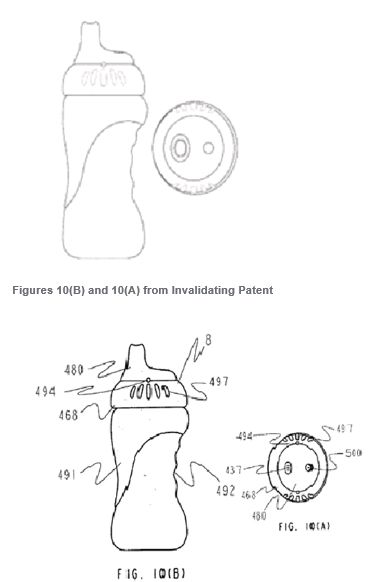Since the inter partes review (IPR) process became available on September 16, 2012, over 1,100 IPR petitions have been filed. But only eight petitions have challenged design patents, representing less than 0.8% of all petitions filed. This trend might change, however, given the recent final written decision in Munchkin Inc. et al. v. Luv N' Care Ltd. (IPR2013-00072), which invalidated Luv N' Care Ltd.'s design patent for a baby drinking cup. The Luv N' Care design patent is the first to fall victim to an IPR challenge.
Munchkin, Inc. and Toys "R" Us, Inc. (collectively, "Petitioner") challenged Luv N' Care's U.S. Design Patent No. D617,465 as being obvious over two of Luv N' Care's own utility patent documents. The asserted references were U.S. Patent Application Publication No. 2007/0221604 and U.S. Patent No. 6,994,225.1 The challenged patent and the asserted references all share the same inventor. Below is a side-by-side comparison between the challenged design and the invalidating design.
Representative Figure from Challenged Patent

During the proceeding, Luv N' Care did not argue that the claimed design of the '465 Patent was distinct from the asserted references. Instead, Luv N' Care argued that the '604 Publication and the '225 Patent were not prior art because the challenged '465 design patent claimed priority to an earlier-filed utility application – namely, the application that resulted in the asserted '604 Publication.
Petitioner, on the other hand, argued that the earlier application lacked adequate written description for the design claimed in the challenged '465 patent, citing to differences between the "spout" shown in the claimed design, and the "spout" shown in the '604 Publication (see different "spout" shapes above, where challenged design has a larger, more oval-shaped spout with concentric rings).
In order to reconcile the difference in spout shapes, Luv N' Care pointed to text in the '604 Publication that described an "oval"-shaped spout. However, the Board found that the text relied upon by Luv N' Care lacked sufficient detail to provide written description for the spout claimed in the figures of the '465 Patent. Accordingly, the Board held that the '465 Patent was not entitled to claim priority to the earlier filing date from the utility patent; thus, the asserted '604 Publication and '225 Patent were invalidating prior art.
It is noteworthy that the disclosure of the '604 Publication was insufficient to provide adequate written description for the design claimed in the '465 Patent, yet at the same time, was similar enough to render the design in the '465 Patent obvious. This incongruous result is likely due in part to the fact that Luv N' Care conceded that the '465 Patent was invalid if not entitled to the earlier priority date of the '604 Publication.
Design patent litigation has received a lot of attention in recent years, presumably sparked by the notorious Apple v. Samsung battle involving the iPhone design. With the examination of design patents being considered by some as a "de facto registration system," where more than 98% of design patents are issued without the Patent Office challenging their inventiveness,2 it seems that design patents are ripe for challenge using the IPR procedure. The Munchkin case might represent the first of many design patents to be invalidated through inter partes review.
Footnotes
1 Although numerous design patents were considered by the examiner during examination of the '465 patent, neither of the invalidating utility references were considered.
2 See Crouch, Dennis D., A Trademark Justification for Design Patent Rights, Harvard Journal of Law and Technology, Vol. 24 (Aug. 10, 2010).
The content of this article is intended to provide a general guide to the subject matter. Specialist advice should be sought about your specific circumstances.




